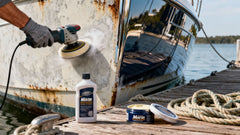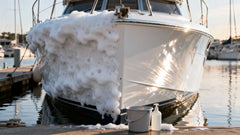how to clean boat windshield: Simple Steps for a Clear View
Knowing how to clean a boat windshield is simpler than you might think. It really comes down to a safe, straightforward process: start with a freshwater rinse to get rid of any abrasive salt and grit, then gently wash it with a cleaner made for marine environments and a soft microfiber towel. The final touch is drying it completely to avoid those annoying water spots, leaving you with a crystal-clear view for safe navigation.
Why a Clear Boat Windshield Is Non-Negotiable
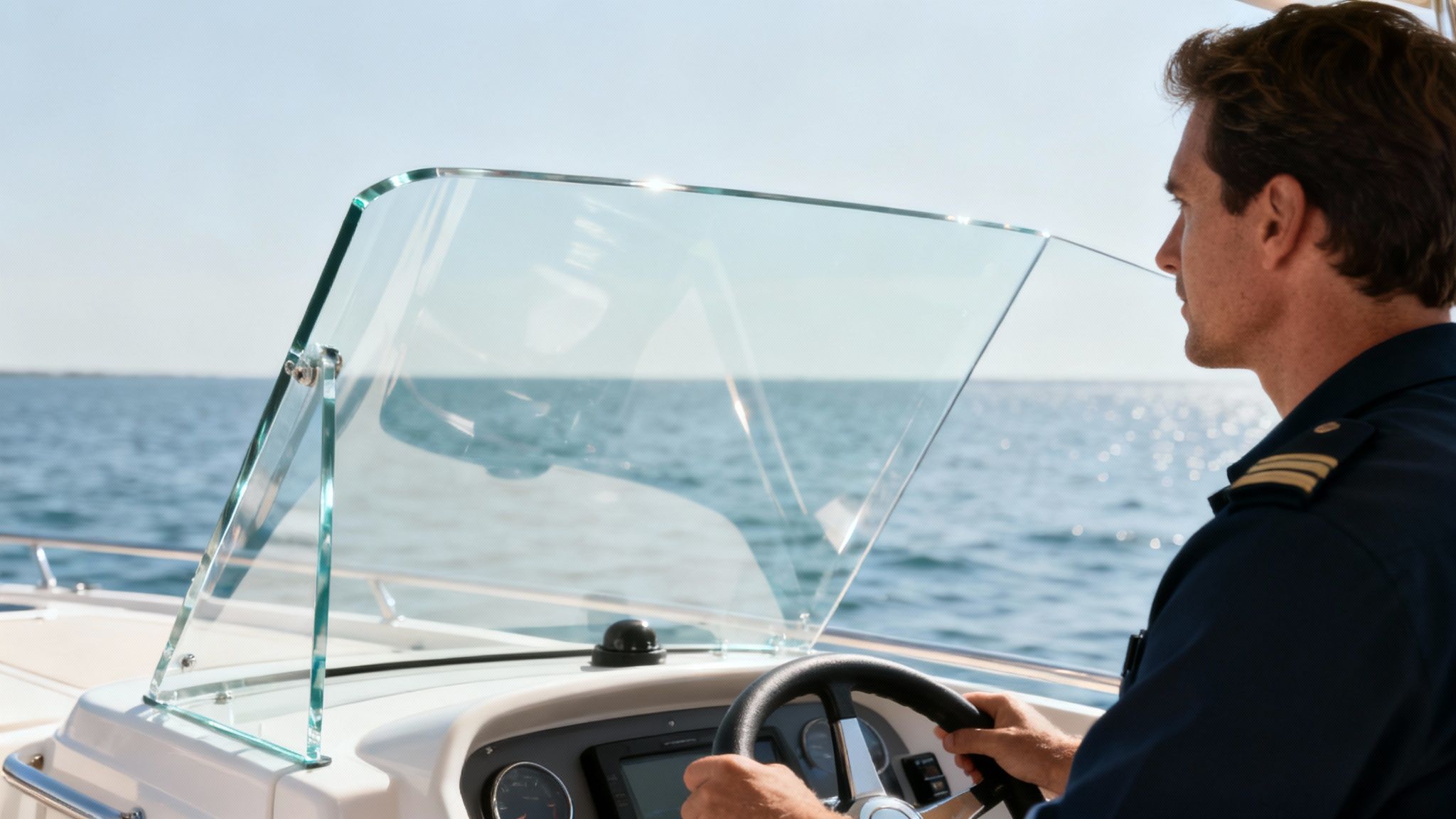
A spotless boat windshield is so much more than just looking good—it's a critical piece of your boat's safety gear. When your vision is blocked by salt spray, haze, or grime, you can easily miss navigation markers, other boats, or debris floating in the water. What starts as a relaxing day can turn into a dangerous one in an instant. A clear line of sight is truly your first defense against collisions and costly mistakes.
This is exactly why you have to treat your windshield with care. A lot of boat windshields aren't actually glass. They’re often made of more sensitive materials like acrylic or polycarbonate, which are tough but can scratch or fog up in a heartbeat if you use the wrong products or techniques.
The Dangers of Improper Cleaning
This is where many boat owners go wrong. Reaching for common household cleaners, especially anything with ammonia like Windex, is one of the worst things you can do. These chemicals can cause permanent damage, creating a cloudy, hazy mess that no amount of scrubbing will ever fix. Over time, they can even make the material brittle and cause tiny stress cracks to spiderweb across the surface.
And this isn't a small problem. The global market for boat windshields was valued at around $2 billion in 2023, which tells you how vital they are. Sadly, it's estimated that about 70% of reported windshield damage on boats comes from nothing more than incorrect cleaning methods—think abrasive cloths or harsh chemicals.
Key Takeaway: Your boat’s windshield is a critical piece of safety gear. Using the wrong cleaner doesn't just risk a cloudy view—it can lead to permanent damage and compromise your safety on the water.
Here’s a quick rundown to keep you on the right track and prevent any costly mistakes.
Essential Dos and Don'ts for Boat Windshield Cleaning
This table is a simple reference guide to help you clean your windshield safely and effectively, avoiding the common pitfalls that can lead to damage.
| Action | Why It Matters |
|---|---|
| DO use a dedicated marine-grade plastic cleaner. | These are formulated to be gentle on acrylic and polycarbonate, preventing chemical damage. |
| DON'T use ammonia-based cleaners (like Windex). | Ammonia causes hazing, cloudiness, and can make the plastic brittle over time. |
| DO rinse with fresh water before washing. | This removes salt crystals and grit that can act like sandpaper and scratch the surface. |
| DON'T use paper towels or rough cloths. | They are abrasive and will leave behind fine scratches and swirl marks. |
| DO use clean, soft microfiber towels. | Microfiber is non-abrasive and effectively lifts away dirt without scratching. |
| DON'T apply heavy pressure when wiping. | Let the cleaner do the work. Scrubbing too hard can easily mar the surface. |
Following these simple rules will make a huge difference in the longevity and clarity of your windshield.
Keeping a clear windshield is a fundamental part of responsible boat ownership. You wouldn't leave the dock without checking your engine or navigation lights, and making sure your view is completely unobstructed should be just as routine. For a full rundown of other essential items, take a look at our comprehensive boat safety equipment checklist. By adopting the right cleaning habits, you’re not just protecting your investment—you’re ensuring every trip is as safe as it is enjoyable.
Gathering Your Windshield Cleaning Toolkit
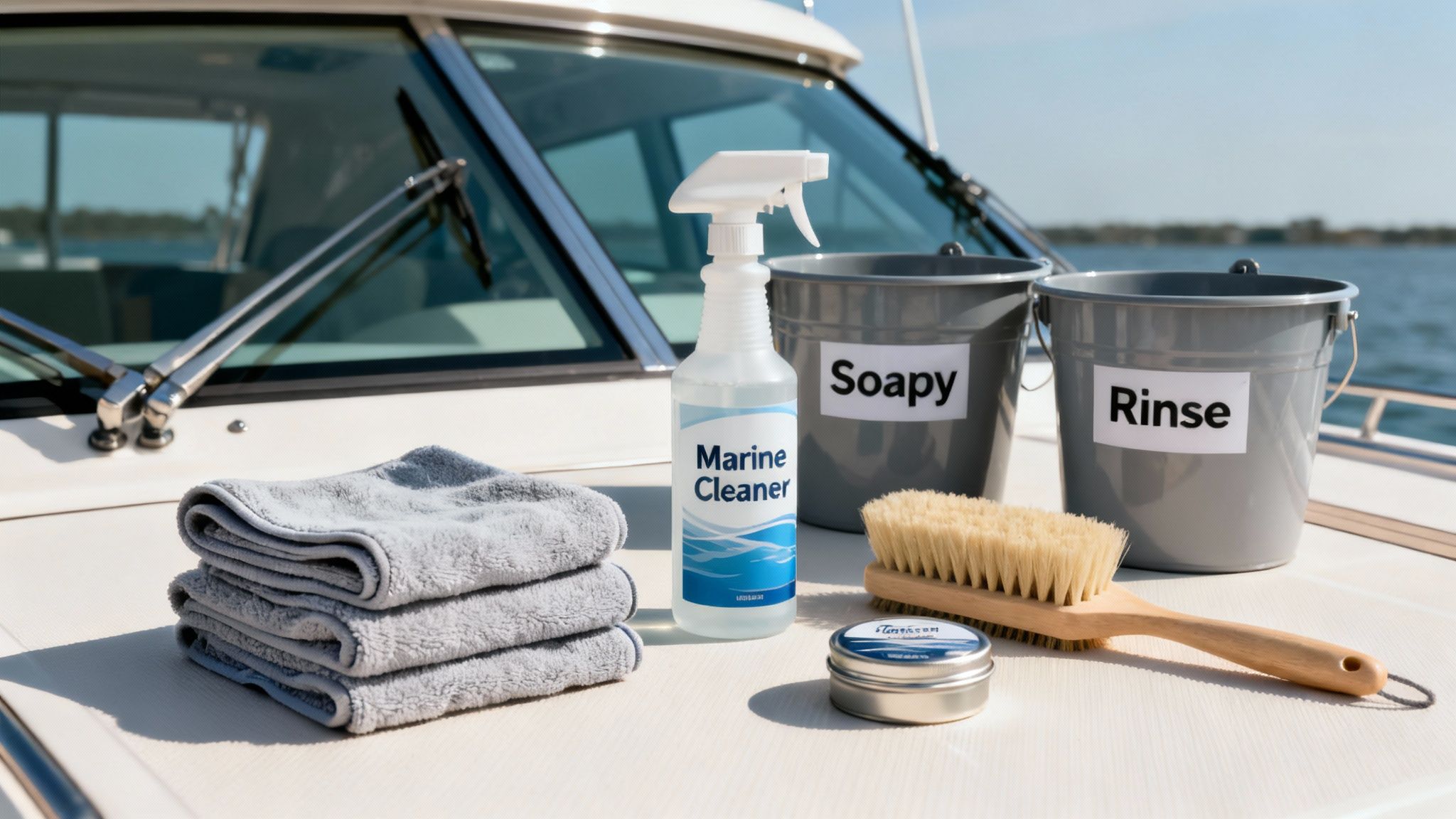
Before you even think about spraying down your boat’s windshield, getting the right gear ready is the secret to a professional, streak-free finish. Grabbing old rags and a bottle of Windex is a recipe for scratches and a permanent haze you'll regret.
Let's put together a proper toolkit that protects your investment and delivers that crystal-clear view every time.
The foundation of any good cleaning kit starts with high-quality microfiber cloths. Forget paper towels—they're way too abrasive for sensitive acrylic and polycarbonate surfaces. You'll want at least three separate cloths to avoid cross-contamination and guarantee a flawless result.
- One for Washing: This cloth gets paired with your cleaning solution to gently lift away all that salt and grime.
- One for Drying: A completely clean, dry cloth is non-negotiable for wiping away moisture and stopping water spots in their tracks.
- One for Protecting: This final cloth is reserved for applying your protective sealant, keeping the application pure and effective.
Choosing the Right Cleaners and Tools
The most critical item in your arsenal is the cleaner itself. In a marine environment, a specialized cleaner isn't just a suggestion; it's a must-have. We always recommend a dedicated Marine All-Purpose Cleaner because its non-abrasive, pH-balanced formula is engineered to safely break down salt on both acrylic and glass without causing damage.
Household products are a hard pass. Many contain harsh chemicals like ammonia that can permanently cloud or even crack plastic windshields over time.
Pro Tip: Make the two-bucket method your new best friend. Fill one bucket with your cleaning solution and the second with clean rinse water. After you wipe down a section of the windshield, rinse your microfiber cloth in the clean water bucket before dipping it back into the soap. This simple habit keeps you from dragging abrasive grit and dirt back across the surface—a leading cause of fine scratches.
To round out your professional-grade toolkit, you just need a few more essential accessories. A soft-bristle brush is perfect for gently working on stubborn spots like bird droppings or dried-on bugs without marring the surface.
Once you’ve achieved that perfect clean, the job isn't quite done. Applying a protective layer is the final, crucial step. Our Boat Wax & Sealant creates a hydrophobic barrier that repels water, salt spray, and dirt. This not only keeps your windshield cleaner for longer but makes your next cleaning job a whole lot easier.
For a deeper dive into what makes a great setup, check out our complete guide to building the ultimate boat cleaning kit.
A Step-By-Step Guide to a Flawless Finish
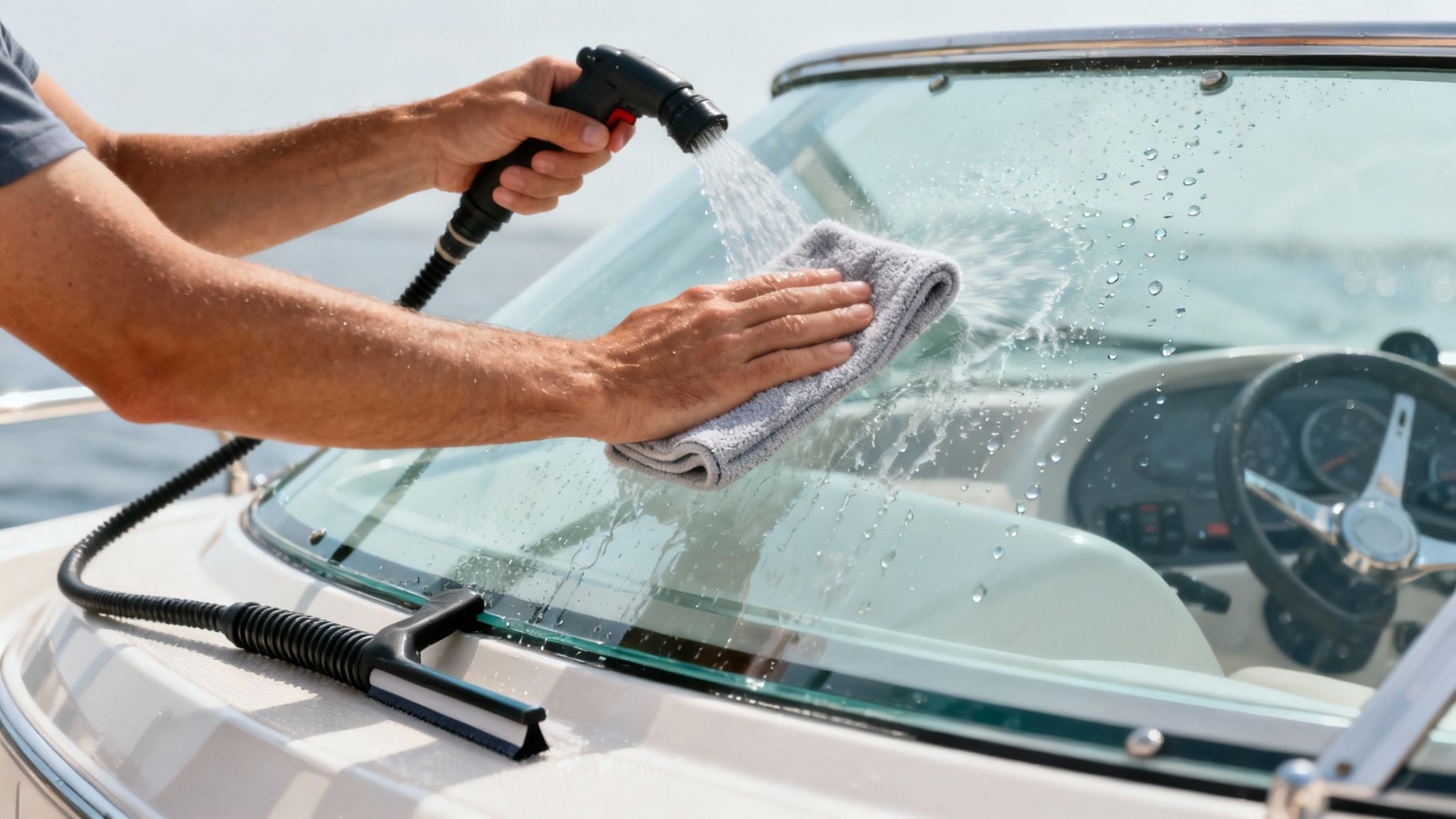
Alright, you’ve got your supplies lined up and you’re ready to tackle that grimy windshield. Getting that invisible-glass look isn’t about brute force; it’s about having a solid process. The goal here is to gently lift the dirt away from the surface, not grind it in.
Before a drop of soap touches that acrylic or polycarbonate, you need to give it a good pre-rinse with fresh water. I can't stress this enough—it's a non-negotiable first move. Think about it: salt crystals, fine sand, and other loose bits are basically sandpaper. Dragging them across the surface with a cloth is a recipe for scratches. A thorough rinse washes them away safely.
The Washing Process
With the loose debris gone, it's time to break out the cleaner. Grab our Marine All-Purpose Cleaner and mix it with water just like the bottle says. Using a clean microfiber cloth that you keep just for this job, gently wash the windshield starting from the top and working your way down. This simple top-down trick keeps dirty water from streaking over the areas you've just cleaned.
Here's a technique that makes a difference: work in straight, overlapping lines instead of swirling circles. This method gives you even coverage and helps you avoid those annoying swirl marks that seem to pop up in direct sunlight. Let the cleaner do the heavy lifting—no need for aggressive scrubbing.
Pro Tip: Timing and temperature are everything. I always try to clean windshields in the shade or on a cooler, overcast day. If the sun is beating down, your cleaner and water will evaporate way too fast, leaving behind a mess of residue and water spots that are a real pain to get off.
Drying for a Spotless Shine
The drying stage is just as critical as the washing part if you want a perfect finish. The second you're done rinsing the cleaner off, you have to get that water off fast. If you let it air dry, you're just asking for mineral deposits and water spots.
A super-absorbent microfiber drying towel is your best friend here. Some people like to use a flexible silicone water blade to squeegee off the bulk of the water first, then follow up with a microfiber towel to nab any leftover drips. Either way, the goal is a bone-dry, spot-free surface.
If you do end up with some stubborn water spots, don't worry, it happens. Our hard water spot remover is specifically formulated to break down these deposits without harming your windshield's delicate surface.
The Final Protective Step
Cleaning gets the grime off, but protection is what keeps your windshield looking clear for the long haul. This last step is what separates a quick clean from proper maintenance. Applying a thin, even coat of our Boat Wax & Sealant creates a tough, hydrophobic barrier.
This sealant does two key things. First, it makes water bead up and roll right off. Second, it creates a slick surface that salt, dirt, and other gunk can't easily stick to. The payoff? Your next cleaning job will be worlds easier and faster. Think of it as an investment that saves you time and effort every time you're on the water.
If you want to dig deeper into achieving that flawless finish, it can be helpful to look into general professional window cleaning techniques. The core principles for getting a perfect shine are pretty universal.
Following a good system like this does more than just make your windshield look good—it protects the material itself. Using the wrong methods or harsh chemicals can actually shorten the life of your polycarbonate or acrylic by up to 20% due to tiny scratches and chemical breakdown. When you use the right stuff, you're not just cleaning; you're preserving your investment.
Solving Tough Windshield Cleaning Problems

Sometimes, a standard wash just won't cut it. Your boat lives in a harsh environment, and it’s going to face tougher challenges than a little dust. From baked-on salt to acidic bird droppings, these stubborn issues require a more specific game plan to solve without causing damage.
This is your troubleshooting guide for the real-world messes your boat encounters. Knowing how to handle these problems safely will not only restore clarity but also prevent you from making a costly mistake in a moment of frustration. Let's break down the most common tough-to-clean culprits.
Tackling Hazy Salt Film and Hard Water Spots
One of the most frequent complaints I hear is about a persistent hazy film that just won’t seem to wipe away. This is usually the result of dried salt spray or hard water minerals that have bonded to the surface over time. If you let it sit, these spots can actually etch into acrylic and become permanent.
For a light, recent film, a simple solution of 50% white vinegar and 50% distilled water can work wonders. The mild acid in the vinegar is perfect for dissolving those pesky mineral deposits.
- Mix the solution in a spray bottle and apply it directly to the spots. Let it sit for a few minutes to do its work.
- Gently wipe it away with a clean, dry microfiber cloth.
- Crucially, rinse the area thoroughly with fresh water afterward. You have to neutralize the acid to prevent it from causing any harm.
When you're dealing with more stubborn, baked-on mineral buildup, you’ll need something with a little more muscle that’s still safe for marine surfaces. This is where a specialized cleaner comes in. Our hard water spot remover is specifically formulated to break down these deposits without harming your windshield's delicate surface.
Expert Tip: Never, ever try to scrape off salt or mineral deposits, especially with a razor blade. While that might fly on your glass windows at home, it will permanently gouge and ruin an acrylic or polycarbonate windshield.
Dealing with Bird Droppings and Light Scratches
It’s an unavoidable part of being on the water—bird droppings will happen. The absolute key here is to act fast. Bird droppings are highly acidic and can permanently etch the surface of your windshield if left to bake in the sun.
Here's how to clean them safely:
- First, soften the dropping by placing a damp microfiber cloth over it for 5-10 minutes. This is the most important step.
- Once it's soft, it should lift away easily without any aggressive wiping or scrubbing.
- Wiping a dry, hard dropping will just drag abrasive grit across the surface and cause a whole new world of scratches.
But what if you already have some minor scratches or swirl marks? Don’t panic. For light, surface-level scuffs on acrylic, a dedicated plastic polishing compound can often restore that crystal-clear view. Just apply a small amount with a clean microfiber applicator and buff gently in a circular motion until the scratch diminishes. Always test on a small, inconspicuous area first to be safe.
To help you stay on track, it's useful to see the common pitfalls right next to the proven methods.
Common Cleaning Mistakes vs. Proven Best Practices
We've all been tempted to grab whatever is handy to clean a tough spot, but that's often where the real damage happens. This table breaks down what not to do and what to do instead.
| Common Mistake | Recommended Best Practice | Potential Damage Caused |
|---|---|---|
| Using paper towels | Using high-quality microfiber cloths | Causes fine scratches and leaves behind lint |
| Wiping in circles on dry spots | Pre-soaking stubborn spots (like bird droppings) | Drags abrasive particles across the surface, creating scratches |
| Using ammonia-based cleaners | Using specialized marine cleaners or a vinegar/water mix | Can cause crazing (fine cracks) and yellowing on acrylic |
| Scraping with razor blades | Using a plastic-safe spot remover and gentle wiping | Deep, permanent gouges and scratches |
| Forgetting to rinse | Thoroughly rinsing with fresh water after cleaning | Leaves behind chemical residue that can damage the surface |
Sticking to the best practices not only makes the job easier but also protects your investment for the long haul.
By having a plan for these tougher issues, you can confidently maintain a perfectly clear view and protect your windshield from long-term damage. It's all about using the right tools and a little bit of patience.
Proactive Care for Long-Term Windshield Clarity
Knowing the right way to clean a boat windshield is one thing, but the real secret to keeping it crystal clear for the long haul is all about proactive care. It’s a shift in mindset—moving from just reacting to grime once it’s built up to actively preventing it from ever getting a foothold.
This approach doesn't just give you a better view; it saves a ton of elbow grease down the road. A protected windshield is simply easier to clean. You're essentially creating a barrier that works for you 24/7, even when the boat is just sitting at the dock.
Building a Protective Barrier
Applying a high-quality protectant is the cornerstone of any good maintenance strategy. Once your windshield is sparkling clean, a coat of a product like our Boat Wax & Sealant every two to three months makes a world of difference. It creates a slick, hydrophobic surface that forces water to bead up and roll right off, taking salt and dirt along for the ride.
This simple step fundamentally changes how your windshield deals with the elements. Instead of letting grime bond and create that stubborn, hazy film, you’re stopping it before it starts.
This isn't just a boater's trick; it's a reflection of a larger trend in marine care. The global market for marine cleaning products hit about USD 100.25 billion in 2024 and is still climbing. That number tells you just how much owners are investing in effective solutions to protect their vessels. For those wanting truly advanced, long-lasting protection, some are even turning to specialized layers like graphene coatings, known for their incredible durability in harsh marine environments.
Think of a protective coating like a non-stick pan for your windshield. It stops salt, dirt, and grime from baking onto the surface, which means your regular rinses are far more effective and your deep cleans are needed way less often.
Defending Against Environmental Damage
Beyond the immediate gunk and grime, the biggest long-term threat to acrylic and polycarbonate windshields is the sun. Year after year of UV exposure is what causes these materials to yellow, turn brittle, and eventually develop those frustrating little cracks.
Your best line of defense here is a good old-fashioned physical barrier.
- Use a Well-Fitting Boat Cover: This is non-negotiable. When you're not using the boat, a quality cover shields the windshield from direct sunlight. It dramatically slows down the UV degradation that ages your acrylic or polycarbonate.
- Perform Pre-Storage Prep: Before putting the boat away for the season, do one last deep clean. After that, apply a fresh coat of protective sealant. This will shield the surface from any dust and moisture that might settle while it's in storage.
Taking these proactive steps ensures your windshield isn't just clean for the next trip out, but is actually being preserved for years of use. It’s a crucial part of maintaining the safety, appearance, and value of your boat.
Got Questions About Your Boat Windshield? We Have Answers.
Even after you've got a solid cleaning routine down, specific questions always seem to pop up. Trust me, I've heard them all. Getting these common queries sorted out is the key to building good habits and, more importantly, avoiding costly mistakes. Let's tackle some of the most frequent questions I hear from fellow boaters.
This isn't just about memorizing a checklist; it's about understanding the why behind each move. Knowing what not to do is often just as critical as knowing the right way to do things.
How Often Should I Clean My Boat Windshield?
Honestly, it all comes down to how and where you're boating. If you spend your time in saltwater, a quick but thorough freshwater rinse after every single trip isn't just a suggestion—it's non-negotiable. That simple step stops corrosive salt crystals from etching themselves into the surface.
As for a full-on soap-and-water clean? A good rule of thumb is every few outings. But the real tell is your own eyes. If your view is even slightly hazy or blocked by salt spray and grime, it's time for a proper wash.
Can I Use Windex On A Boat Windshield?
Let me be blunt: this is a hard no. It's probably the single most common—and most damaging—mistake I see boat owners make. The vast majority of boat windshields aren't glass. They're made from acrylic (you might know it as Plexiglas) or polycarbonate (like Lexan).
Household glass cleaners like Windex are packed with ammonia, and ammonia is the mortal enemy of these plastics. Over time, it will cause the material to get cloudy and brittle, and can even lead to a network of fine cracks called "crazing." Always, always stick to a dedicated, ammonia-free marine cleaner.
Key Insight: Wiping a salt-crusted windshield without rinsing it first is like taking fine-grit sandpaper to it. Those sharp salt crystals are incredibly abrasive and will carve a web of micro-scratches into the surface, permanently dulling your view.
What Is the Best Way to Remove Salt Spray Without Scratching?
The absolute golden rule for safely removing salt spray is to dissolve and wash the salt away before a cloth ever touches the surface. I can't stress this enough: never, under any circumstances, wipe a dry, salt-covered windshield.
Start with a generous drenching of fresh water from a regular garden hose. Just let the water flow over the whole surface for a minute or two. This gives it time to dissolve all those abrasive crystals. Only after this pre-rinse is it safe to grab your marine soap and a soft microfiber cloth.
Is It Safe to Use a Pressure Washer on My Windshield?
I'd strongly advise against it. That high-pressure stream can wreak havoc on the sensitive rubber seals and gaskets framing your windshield, which is a fast track to developing leaks. Plus, that much force can be too harsh for the surface of acrylic or polycarbonate itself, potentially causing damage.
A standard garden hose with a gentle spray nozzle gives you all the pressure you need to get the job done right, without any of the risk.
For a safe, effective clean every single time, you've got to trust the products designed for the marine environment. Better Boat offers a complete lineup of marine-safe cleaners and protectants to keep your windshield crystal clear. Check out our All-Purpose Cleaner to get started on the right foot.


